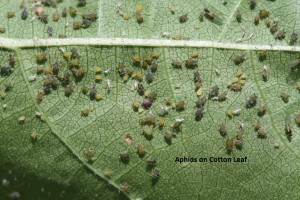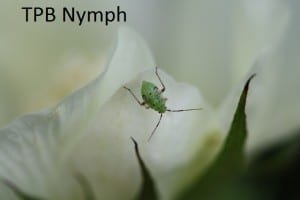As we move into the third week of squaring on many fields, with some earlier field having 12+ nodes, I’ve had some calls about plant bugs and aphids. Below are some points to consider for each of these pests.
 Cotton aphids are generally more show than go. Unless high infestations persist for a long time, they generally do not cause yield loss. In the past, applications of Centric or imidacloprid products have provided early season control. You may see some suppression with these products, but cotton aphids have developed resistance to the neonicotinoid insecticides. The bad news is they will no longer work very well on aphids, but the good news is they typically don’t make them worse.
Cotton aphids are generally more show than go. Unless high infestations persist for a long time, they generally do not cause yield loss. In the past, applications of Centric or imidacloprid products have provided early season control. You may see some suppression with these products, but cotton aphids have developed resistance to the neonicotinoid insecticides. The bad news is they will no longer work very well on aphids, but the good news is they typically don’t make them worse.
UT’s early-season threshold (prior to flowering) is to make an insecticide application “if aphids are present on numerous plants and some leaves are curled along the edges (signs of stress), particularly if the crop is already suffering from drought stress.” Among the neonicotinoids, Intruder or Strafer at 0.75-1.1 oz/acre should help suppress aphids. Carbine is a good option at 1.5-2.5 oz/acre. Neither of these products provide great plant bug control , so you might consider mixing them with Centric or imidacloprid. If plant bugs are present, Transform WG will also provide good control of aphids. You could also consider reduced rates of Transform mixed with Acephate, Centric or imidacloprid to reduce costs and improve plant bug control and keep the price down. However, Transform is only labeled under a Section 18 for plant bug control, and should not be used unless your main target is tarnished plant bugs.
 Tarnished plant bug pressure is still spotty but increasing, and I’ve had some reports of immatures in early planted fields. It is in these earlier fields, where nymphs are showing up, that I would consider applying Transform, typically at 1.5 oz/acre. Another good option would be to use Diamond (4-6 oz) mixed with something to control adults. This mix partner could be Acephate/Orthene, Centric or imidacloprid, or even Transform. Remember that dicrotophos (e.g., Bidrin) cannot be applied between first square and first flower. Personally, I would consider going with the cheaper combo (Diamond + acephate or imidacloprid) and coming back as needed with Transform on the next application. This makes a little more sense to me because Acephate or Diamond can flare aphid applications (so a subsequent application of Transform would help mitigate that problem).
Tarnished plant bug pressure is still spotty but increasing, and I’ve had some reports of immatures in early planted fields. It is in these earlier fields, where nymphs are showing up, that I would consider applying Transform, typically at 1.5 oz/acre. Another good option would be to use Diamond (4-6 oz) mixed with something to control adults. This mix partner could be Acephate/Orthene, Centric or imidacloprid, or even Transform. Remember that dicrotophos (e.g., Bidrin) cannot be applied between first square and first flower. Personally, I would consider going with the cheaper combo (Diamond + acephate or imidacloprid) and coming back as needed with Transform on the next application. This makes a little more sense to me because Acephate or Diamond can flare aphid applications (so a subsequent application of Transform would help mitigate that problem).

